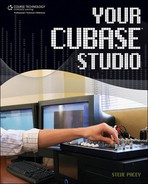Bypassing a Recording Console and Recording a Band
In the previous example, the band was monitoring their performance directly from the analog Mackie mixer. There was no need to monitor from tracks they were recording. Because the band was monitoring from their input signal rather than their output signal, there was no noticeable latency in the monitoring process and the buffer could be increased to help your system perform better without worry of affecting the monitoring.
Though this style of recording and monitoring can be very useful, the best signal is the one with the least resistance. This means that bypassing the console and running the signal directly to the sound card can be better than running the signal through a console. The real problem with bypassing a console in the recording chain is latency and other monitoring issues. You can group and bus in Cubase just as you can with the Mackie mixer (see Figures 7.21 and 7.22). If you think about it, it makes perfect sense to bypass a recording console, especially when working with lower-end recording consoles.
Cubase 4 is set up to deal with more monitoring issues in the studio than other Cubase versions. As technology develops, we’ll have less of a need for analog mixers, but as it stands right now, the technology available is in a lot of ways inferior to the classic style of recording a band through an analog console. Signal flow with a physical analog mixer is a little easier for most people to understand than it is on a virtual mixer (such as the one found in Cubase) that hides buttons and contains drop-down menus for routing. But both the analog and digital worlds can be difficult to understand if you don’t understand signal flow.
Cubase 4 contains several analog console features that take recording directly into the computer to new levels.
The control-room features completely separate output busses for control room and headphone monitoring, leaving the main mix output untouched by control room–specific settings. This is similar to bussing and using the Master Outs on an analog console.
It also features four user-definable monitor setups, similar to having a headphone jack for every monitor mix in order to make adjustments to individual monitor mixes. This allows you to hear each setup as it sounds from the monitor.
Six external inputs (for external sources such as DAT, tape, CD, or DVD) are also available and can be played through any studio, track, headphone, or control room bus. This is a nice feature, but keep in mind that it also requires multiple inputs on your sound card.
Four separate studio/monitor mixes—each getting its signal feeds from any audio channel, group channel, or FX return channel—are also available within the Cubase mixer. Each of the four independent studio sends offers level and pan controls. This is similar to using the sends and monitor sections on an analog board.
An integrated talkback function, which works along with an input on your sound card. Any microphone you plug into it is available in Cubase’s control room.
A copy function to apply the main mix to any of the studio mixes with a single mouse click or key command. This is possible on some external digital consoles, but not on an analog board.
Since your click (metronome) is most likely coming from Cubase, the mixer includes a special click bus that is always patched in.
While the list of control room–like functions within Cubase 4 sounds very promising, you’re still limited by the number of inputs and outputs on your sound card and by your computer’s power. Even if your computer has the necessary power to remove latency while recording, you still may need an external mixer to submix other audio signals (such as the MIDI instruments in the previous example).


